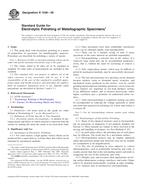Potrebujeme váš súhlas na využitie jednotlivých dát, aby sa vám okrem iného mohli ukazovať informácie týkajúce sa vašich záujmov. Súhlas udelíte kliknutím na tlačidlo „OK“.
ASTM E1558-09
Standard Guide for Electrolytic Polishing of Metallographic Specimens
Automaticky preložený názov:
Štandardné Príručka pre galvanické leštenie metalografických vzoriek
NORMA vydaná dňa 1.5.2009
Informácie o norme:
Označenie normy: ASTM E1558-09
Poznámka: NEPLATNÁ
Dátum vydania normy: 1.5.2009
Kód tovaru: NS-42182
Počet strán: 14
Približná hmotnosť: 42 g (0.09 libier)
Krajina: Americká technická norma
Kategória: Technické normy ASTM
Anotácia textu normy ASTM E1558-09 :
Keywords:
electrolytic polishing, electropolishing , polishing, specimen preparation (metallographic), Alcohol, Alkaline electrolytes, Chromium trioxide, Electrolytic polishing, Electropolishing, Glacial acetic acid, Metallic coatings, Metallographic preparation, Methanol (methyl alcohol), Methyl alcohol, Nitric acid, Perchloric acid, Phosphoric acid, Specimen preparation (metallographic), Sulfuric acid, ICS Number Code 25.220.20 (Surface treatment)
Doplňujúce informácie
| Significance and Use | ||||
|
Advantages of Electrolytic Polishing: For some metals, a high quality surface finish can be produced that is equivalent to, or better than, that which can be obtained by mechanical methods. Once procedures have been established, satisfactory results can be obtained rapidly with reproducibility. There can be a marked saving of time if many specimens of the same material are polished sequentially. Electropolishing a selected area on the surface of a relatively large metal part can be accomplished nondestructively, that is, without the need for sectioning to remove a piece. Soft, single-phase metals, which may be difficult to polish by mechanical methods, may be successfully electropolished. The true microstructure of a specimen can be obtained because artifacts (such as disturbed metal, scratches, and mechanical twins) produced on the surface, even by careful grinding and mechanical polishing operations, can be removed. These features are important in low-load hardness testing, X-ray diffraction studies, and in electron microscopy, where higher resolution puts a premium on undistorted metal surfaces. After electropolishing is completed, etching can often be accomplished by reducing the voltage (generally to about one-tenth that required for polishing) for a short time before it is turned off. Note 2—Not all electropolishing solutions produce good etching results. Disadvantages of Electrolytic Polishing: Many of the chemical mixtures used in electropolishing are poisonous or dangerous if not properly handled (see Section 5). These hazards are similar to those involved in the mixing and handling of etchants, see Test Methods E 407. In multi-phase alloys, the polishing rate of each phase may be different. The result may be a non-planar surface. Electropolished surfaces may be slightly undulated rather than perfectly planar and, therefore, may not be suitable for examination at all magnifications. The rate of polishing in areas adjacent to various inhomogeneities, such as nonmetallic inclusions and voids, is usually greater than that in the surrounding matrix and tends to exaggerate the size of the inclusions and voids. Dimples, pits, and waviness limit applications involving surface phenomena, coatings, interfaces, and cracks. Edges tend to be attacked preferentially, resulting in edge rounding. Artifacts may be produced by electropolishing. Specimen mounting materials may react with the electrolyte. The electropolished surfaces of certain materials may be passive and difficult to etch. Metal removal rates by electropolishing are usually quite low, typically about 1 μm/min, and all of the prior induced damage from cutting and grinding may not be removed if preparation is stopped after a 600-grit SiC grind and electropolishing times are short. A large number of electrolytes may be needed to polish the variety of metals encountered by a given laboratory. Considerable time may be required to develop a procedure for a new alloy. |
||||
| 1. Scope | ||||
|
1.1 This guide deals with electrolytic polishing as a means of preparation of specimens for metallographic purposes. Procedures are described for polishing a variety of metals. Note 1—References (1-133) on electrolytic polishing will provide the reader with specific information beyond the scope of this guide. 1.2 The values stated in SI units are to be regarded as standard. No other units of measurement are included in this standard. 1.3 This standard does not purport to address all of the safety concerns, if any, associated with its use. It is the responsibility of the user of this standard to establish appropriate safety and health practices and determine the applicability of regulatory limitations prior to use. Specific safety precautions are described in Section 5 and 6.3.1. |
||||
| 2. Referenced Documents | ||||
|
Odporúčame:
EviZak - všetky zákony vrátane ich evidencie na jednom mieste
Poskytovanie aktuálnych informácií o legislatívnych predpisoch vyhlásených v Zbierke zákonov od roku 1945.
Aktualizácia 2x v mesiaci !
Chcete vedieť viac informácii ? Pozrite sa na túto stránku.




 Cookies
Cookies
